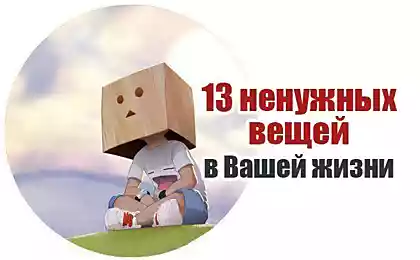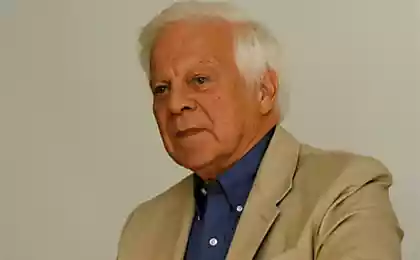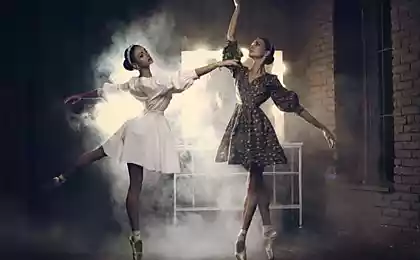555
Creators of personal catastrophes: stop messing with old wounds
It seems that she is firmly holding the helm and lead the ship of my life, consciously choosing one or the other route, anticipating and preventing the possible ship in a storm and broke. She believes that free choice and always do what's best for her…
Only reason over and over again for more than thirty years, she gets into the same situation: betray her friends, men break up with her after our third date, and bosses always drops all her work and he always found reasons for dissatisfaction and criticism. She explains all of this gross injustice, which traditionally complains of fate, and blames everyone around and continues to hope that with the advent of the new man or the new chief will be different…
Surprisingly often repeated story. Customers come one by one, changing gender, age, circumstances. But everyone has something that is repeated over and over again with depressing regularity, and they are angry, upset, hurt, complain and can't understand why they all happen that way. Just once, perhaps very long ago, all that happened to them the first time.
Fifty four million four hundred seventy nine thousand six hundred fifty three
Everything that happens to us changes us. Early trauma is something that happened to us when we were kids. Event or a series of episodes that changed our psychological structure, to determine how to continue to build our adult lives, even if the injury has been forgotten and buried under a bushel new, like a completely unrelated event.
Early psychological trauma has its own laws.
1. It is always the unexpected. It is impossible to prepare. It sneaks up on you. She usually puts the child in a feeling of helplessness, inability to defend themselves. Very often at the time of injury, he falls into an emotional stupor, without experiencing strong feelings, unable to be angry or to fight back.
It freezes and doesn't even know how to feel about that. Only later the emotion is activated, and the child may experience pain, horror, shame, fear, etc. Strong, indigestible mental trauma can be repressed and not remembered in years. But her postdictive continues to operate and shape the behaviour of a person in his their adult lives.
2. It happened in a situation when the little child than he could manage. At the time of injury, the child suddenly loses control of the situation because all power and control in this moment, as a rule, the adult who somehow is related to the injury. The child is very vulnerable to those changes that brings to his life the injury.
And since then, he practically carries the possible unpredictability, trying to organize their world, carefully thinking through the possible steps and consequences, almost always refuses to take any risks and is sensitive to any changes. Anxiety becomes his eternal companion, the desire to control the world around is a necessity.
3. Childhood trauma changes the world. The child before the injury believes that the world works a certain way: it is love, it always protects, he is good, his body is clean and nice, welcome people, etc. the Injury can make adjustments to their hard: the world becomes hostile, the closest person can betray or humiliate, your body need to be shy, he is stupid, ugly, unworthy of love…
For example, to injury, the child was convinced that his dad loves him and will never hurt, but after the drunk father raises the daughter's hand, the world becomes different: in it a man who likes to hurt you at any moment, and you will be scared, and there's nothing you can do.
Or another case: a little girl fun spinning, causing her skirt swirls around little feet, beautiful waves, and she feels so light, flying, magically beautiful. My mother's shout: "Stop skirt wind! I am ashamed before the whole world cowards sparkle!"— everything is irreversibly changing.
Now it will always be impossible to behave as though something sexy and attractive, because now in her world women attractiveness is strictly forbidden in the avoidance of unbearable shame that she doesn't even remember where it came from.
4. In later life such a person there is a constant retraumatization. That is, the child, even growing up, unconsciously organising and reproduces the events, repeating the emotional component of trauma. If as a child he was rejected by his peers, in his later life in each community it will so affect the field around it that will cause the rejection of others, and he himself will again suffer. Girl, beaten by drunk father, with a high degree of probability can "organize" themselves drinking or abusive husband or partner. And again... to complain of destiny.
I call it "turn the tattered side." Unconscious desire, absolutely unwilling to expose to the world their unhealed trauma, in which an unsuspecting world will punch or tear it off your rising crust. Amazing what a former traumatized children suffer from it, and the tenacity with which they organize their lives so that everything was also hurt.
5. Traumatized children, already growing, can't afford to be happy. Because happiness, stability, joy, success is something that was with them before the injury happened. They were happy and all of a sudden their world is changing and that it is catastrophic for their children's consciousness.
Ever since then happiness and peace for them – it's the feeling of inevitable impending disaster. They may not love the holidays, frown on someone's compliments and assurances of love, not to believe those who are interested in them with the best intentions, to destroy the family idyll, bringing everything to a scandal... as soon As the horizon of their life the sun starts to Shine, they're going to make burst into a huge dramatic storm.
What is very often a storm, not even arranged their hands: suddenly the husband gets drunk before a long-awaited trip, all children get sick, throw your favorite, there is a reduction in work, etc. Everything happens as if without their direct participation, but with depressing regularity.
The whole world rushes to the aid that they need at any cost to reproduce the injury, only in this case, all unconsciously to take control, now they will not allow to happen suddenly, like when it was the first time. Now they are convinced that when all is well, always happens something terrible. And it will certainly happen, because the world always goes to meet them…
6. Trauma is not always a key event. This can be a constant psychological pressure on the child, attempt to change it, the criticism in which he lives day by day, his sense of uselessness parents, constant feeling of guilt for what he is and everything he does.
Often the child grows up with some sometimes badly perceived by the message, "I shall please", "all around more valuable than me", "nobody care about me" "I am the way, nothing smoked heaven" and all others, crippling his psyche and creates retraumatizing reality. To work with such messages, which in adult life are firmly embedded in the mental frame is not easy. Because not even the memory of how to live without these messages, there is no experience of life before the injury.
7. It's hard not to agree with Freud, who suggested that the earlier the trauma, the harder the healing process. Early trauma is bad, remember, earlier embedded in the psychological constructs of the child, changing them and setting new conditions in which the psyche is then operational. So early "disability" leads to the fact that the world seems exactly as his early childhood took the child.
And it's just impossible to find and pull a curve or a traumatic construct of the mind, without exposing the risk of collapse of the whole mental structure. Well, that clients have psychological protection, which greatly protect the psyche from such operations. Therefore, the work with early trauma more like an archaeological dig, than surgery.
Fourteen million four hundred twenty three thousand three hundred seventy three
Working with early trauma
Not every trauma remains in the mind for a long time and then change psychological constructs. The only one that has not been lived properly. From the practice I noticed that this happened in cases where:
the child was unprotected, he did not provide the support that he experienced an acute sense of insecurity and powerlessness;
the situation was clearly in conflict (e.g., humiliates or causes harm to the one who should protect and love) and the child had emotional and cognitive dissonance that nobody helped him to solve;
the child couldn't defend himself, couldn't prove, and sometimes even allow yourself to feel aggressive feelings towards the traumatic object;
work displacement due to severe danger for the psyche of the child, or he can remember about the situation, but "skip" some emotions and feelings that were too heavy to stay in the moment;
the child, unable to discuss the injury situation, "drew conclusions" about how the world works, and unknowingly built protection from the world, making it globally traumatic.
If we are dealing just received childhood trauma, respectively, then we work with the child and his family. It is important, talking with the child in his language, to use the funds according to the age: toys, painting, play, tales, talk to the child about the traumatic experience.
At the age of 10, you can use indirect methods to work with your child to organize his space and the ability to play the situation on a symbolic level. In most cases, children use this opportunity, and trauma begins to manifest itself in drawings, games, conversations. We have to be sensitive and maintain it in expression of feelings and the processes that begin to flow in our office.
A "fresh" injury, as a rule, easily comes to the surface as soon as the child begins to feel trust, acceptance of his therapist and safety. It is important to focus on what feelings the child avoids to live, how he perceives the world, and how to evaluate their participation in a traumatic situation, and the actions of those who hurt him.
If we work with adults who received a childhood injury, it is important to keep in mind:
1. Injury securely "buried" and kontenerowy, and often you will not be able to get a "direct access", even if you believe that she was, and even know what kind it is, and what violations she has brought to your customer. The client can long time to deny that his past life at least some significant traumatic events. Customer long been accustomed to consider their "tattered sides" rule, in which he lives. And it is often not a clear link his current problems with an injury which you suspect.
2. Mental structure of the adult client is fairly stable. And despite the fact that it has been brings to life the client a lot of grief, suffering and difficulties, he will not rush to abandon it. Because for many years she served him "faithfully", and besides, once protected from heavy and hard to bear situation.
3. The client is afraid even to come close to the feelings that were experienced (and, most likely, is not fully experienced) them once, and therefore the resistance as you get closer to the traumatic past situation will sharply grow. Often it is through his presence and power we can assume that we are somewhere close.
4. Therefore working with early childhood trauma in an adult may not be a short-term because it is required to pass several stages, which each client (depending on the nature of the injury, extent of violations, characteristics built after her defenses) will take its unpredictable time.
The stages of work from early childhood trauma in an adult client:
1. The formation of a strong working Alliance, trust, security, acceptance. At this stage, the client usually talks about their problems in life, preferring not to go into, but subconsciously, he checks the therapist to mesocenozoic and acceptance. It is impossible even to get a difficult experience with a person, whom you do not trust, and which is thoroughly not tested by you, especially if before you were injured.
2. The gradual training of the client awareness and the habit of looking at their problems not only from the point of view of "what the world is doing to me", but from the standpoint of "what am I doing with the world that he's with me." The development in it of the ability to see your authorship in shaping the models on which he now lives.
3. With him to explore when and how these patterns are formed. What was the life of our client that he had these views of the world, attitudes, ways of contact with the world, to build and destroy relationships.
4. To see and accept his "disability» for example, the inability to grow in love, to have parents who understood and supported, the inability to believe in themselves, as do people who have never had these injuries and problems, inability to trust, to love themselves, or is the world, as do "healthy" people.
5. Over and over again to experience strong feelings about still discovered the traumatic situation and its consequences: sadness, bitterness, anger, shame, guilt, etc. the Therapist it is important to note what feelings the client is difficult to afford to survive. Often clients find it difficult to survive the anger towards the "rapists", which both were his close friends, parents, brothers, sisters.
6. To get rid of guilt (or its parts), dividing (or stream it in full) responsibility with those who was a participant or source of childhood trauma. Understanding and sharing the suffering of that child, who had been then kind of violence and were helpless and "unarmed". Inner child, abused and injured, continues to live inside adults and continues to suffer. The task of our clients: to accept, to protect and to comfort. Very often adults refer to their internal injured child with understanding, and with judgment, criticism, shame that only reinforces the devastating effect of trauma.
7. Injury have largely shaped the psychological "disability» due to the fact that the child did not protect those who were supposed to protect. Our task – to teach adult client to protect your inner child and always be on his side. This will allow him to avoid injuries in the future and will save it from future retraumatisation.
8. Gradually together with the client to rebuild the habitual frame of his psychological constructs and attitudes showing him how I helped him and worked the constructs that he had in childhood, and as they are not adaptive or destructive now, in his adult life, especially when it's the only way to react.
Together with the client find his own resources and possibilities in order to endure the unpredictability and to build a life without suspense and endless reproduction of the injury. The client is also important to feel own power over your life that were traumatic taken away those who were called to care for and train to use it.
Thus,adult client, who has worked his early childhood trauma, gets a wide range of opportunities to build their lives. He always remains the same, taken from childhood, the ability to respond (to withdraw into themselves, or try to turn on the charm or be very obedient, or attack in a protective order). But the former method is added, and others, many of whom can significantly better to approach a given situation.
Thought is the most highly organized form of energy
8 words, that is to say less
Adult client stops responding unconsciously to "pull" the old wounds. They are neatly bandaged, and gradually scars, leaving behind scars that are not so sick. The client understands where and how he's wounded, and treats his ills with respect, consideration, and not allow others again bring him pain. And he finally allows himself to live successfully and happily, ceasing to control the entire world around in a disturbing creation of personal disaster.
Author: Irina Mlodik
P. S. And remember, only by changing their consumption — together we change the world! ©
Source: www.facebook.com/notes/irina-mlodik/%D1%81%D0%BE%D0%B7%D0%B8%D0%B4%D0%B0%D1%82%D0%B5%D0%BB%D0%B8-%D0%BB%D0%B8%D1%87%D0%BD%D1%8B%D1%85-%D0%BA%D0%B0%D1%82%D0%B0%D1%81%D1%82%D1%80%D0%BE%D1%84-%D0%B8%D0%BB%D0%B8-%D0%BA%D0%B0%D0%BA-%D0%BF%D0%BE%D0%B7%D
Only reason over and over again for more than thirty years, she gets into the same situation: betray her friends, men break up with her after our third date, and bosses always drops all her work and he always found reasons for dissatisfaction and criticism. She explains all of this gross injustice, which traditionally complains of fate, and blames everyone around and continues to hope that with the advent of the new man or the new chief will be different…
Surprisingly often repeated story. Customers come one by one, changing gender, age, circumstances. But everyone has something that is repeated over and over again with depressing regularity, and they are angry, upset, hurt, complain and can't understand why they all happen that way. Just once, perhaps very long ago, all that happened to them the first time.
Fifty four million four hundred seventy nine thousand six hundred fifty three
Everything that happens to us changes us. Early trauma is something that happened to us when we were kids. Event or a series of episodes that changed our psychological structure, to determine how to continue to build our adult lives, even if the injury has been forgotten and buried under a bushel new, like a completely unrelated event.
Early psychological trauma has its own laws.
1. It is always the unexpected. It is impossible to prepare. It sneaks up on you. She usually puts the child in a feeling of helplessness, inability to defend themselves. Very often at the time of injury, he falls into an emotional stupor, without experiencing strong feelings, unable to be angry or to fight back.
It freezes and doesn't even know how to feel about that. Only later the emotion is activated, and the child may experience pain, horror, shame, fear, etc. Strong, indigestible mental trauma can be repressed and not remembered in years. But her postdictive continues to operate and shape the behaviour of a person in his their adult lives.
2. It happened in a situation when the little child than he could manage. At the time of injury, the child suddenly loses control of the situation because all power and control in this moment, as a rule, the adult who somehow is related to the injury. The child is very vulnerable to those changes that brings to his life the injury.
And since then, he practically carries the possible unpredictability, trying to organize their world, carefully thinking through the possible steps and consequences, almost always refuses to take any risks and is sensitive to any changes. Anxiety becomes his eternal companion, the desire to control the world around is a necessity.
3. Childhood trauma changes the world. The child before the injury believes that the world works a certain way: it is love, it always protects, he is good, his body is clean and nice, welcome people, etc. the Injury can make adjustments to their hard: the world becomes hostile, the closest person can betray or humiliate, your body need to be shy, he is stupid, ugly, unworthy of love…
For example, to injury, the child was convinced that his dad loves him and will never hurt, but after the drunk father raises the daughter's hand, the world becomes different: in it a man who likes to hurt you at any moment, and you will be scared, and there's nothing you can do.
Or another case: a little girl fun spinning, causing her skirt swirls around little feet, beautiful waves, and she feels so light, flying, magically beautiful. My mother's shout: "Stop skirt wind! I am ashamed before the whole world cowards sparkle!"— everything is irreversibly changing.
Now it will always be impossible to behave as though something sexy and attractive, because now in her world women attractiveness is strictly forbidden in the avoidance of unbearable shame that she doesn't even remember where it came from.
4. In later life such a person there is a constant retraumatization. That is, the child, even growing up, unconsciously organising and reproduces the events, repeating the emotional component of trauma. If as a child he was rejected by his peers, in his later life in each community it will so affect the field around it that will cause the rejection of others, and he himself will again suffer. Girl, beaten by drunk father, with a high degree of probability can "organize" themselves drinking or abusive husband or partner. And again... to complain of destiny.
I call it "turn the tattered side." Unconscious desire, absolutely unwilling to expose to the world their unhealed trauma, in which an unsuspecting world will punch or tear it off your rising crust. Amazing what a former traumatized children suffer from it, and the tenacity with which they organize their lives so that everything was also hurt.
5. Traumatized children, already growing, can't afford to be happy. Because happiness, stability, joy, success is something that was with them before the injury happened. They were happy and all of a sudden their world is changing and that it is catastrophic for their children's consciousness.
Ever since then happiness and peace for them – it's the feeling of inevitable impending disaster. They may not love the holidays, frown on someone's compliments and assurances of love, not to believe those who are interested in them with the best intentions, to destroy the family idyll, bringing everything to a scandal... as soon As the horizon of their life the sun starts to Shine, they're going to make burst into a huge dramatic storm.
What is very often a storm, not even arranged their hands: suddenly the husband gets drunk before a long-awaited trip, all children get sick, throw your favorite, there is a reduction in work, etc. Everything happens as if without their direct participation, but with depressing regularity.
The whole world rushes to the aid that they need at any cost to reproduce the injury, only in this case, all unconsciously to take control, now they will not allow to happen suddenly, like when it was the first time. Now they are convinced that when all is well, always happens something terrible. And it will certainly happen, because the world always goes to meet them…
6. Trauma is not always a key event. This can be a constant psychological pressure on the child, attempt to change it, the criticism in which he lives day by day, his sense of uselessness parents, constant feeling of guilt for what he is and everything he does.
Often the child grows up with some sometimes badly perceived by the message, "I shall please", "all around more valuable than me", "nobody care about me" "I am the way, nothing smoked heaven" and all others, crippling his psyche and creates retraumatizing reality. To work with such messages, which in adult life are firmly embedded in the mental frame is not easy. Because not even the memory of how to live without these messages, there is no experience of life before the injury.
7. It's hard not to agree with Freud, who suggested that the earlier the trauma, the harder the healing process. Early trauma is bad, remember, earlier embedded in the psychological constructs of the child, changing them and setting new conditions in which the psyche is then operational. So early "disability" leads to the fact that the world seems exactly as his early childhood took the child.
And it's just impossible to find and pull a curve or a traumatic construct of the mind, without exposing the risk of collapse of the whole mental structure. Well, that clients have psychological protection, which greatly protect the psyche from such operations. Therefore, the work with early trauma more like an archaeological dig, than surgery.
Fourteen million four hundred twenty three thousand three hundred seventy three
Working with early trauma
Not every trauma remains in the mind for a long time and then change psychological constructs. The only one that has not been lived properly. From the practice I noticed that this happened in cases where:
the child was unprotected, he did not provide the support that he experienced an acute sense of insecurity and powerlessness;
the situation was clearly in conflict (e.g., humiliates or causes harm to the one who should protect and love) and the child had emotional and cognitive dissonance that nobody helped him to solve;
the child couldn't defend himself, couldn't prove, and sometimes even allow yourself to feel aggressive feelings towards the traumatic object;
work displacement due to severe danger for the psyche of the child, or he can remember about the situation, but "skip" some emotions and feelings that were too heavy to stay in the moment;
the child, unable to discuss the injury situation, "drew conclusions" about how the world works, and unknowingly built protection from the world, making it globally traumatic.
If we are dealing just received childhood trauma, respectively, then we work with the child and his family. It is important, talking with the child in his language, to use the funds according to the age: toys, painting, play, tales, talk to the child about the traumatic experience.
At the age of 10, you can use indirect methods to work with your child to organize his space and the ability to play the situation on a symbolic level. In most cases, children use this opportunity, and trauma begins to manifest itself in drawings, games, conversations. We have to be sensitive and maintain it in expression of feelings and the processes that begin to flow in our office.
A "fresh" injury, as a rule, easily comes to the surface as soon as the child begins to feel trust, acceptance of his therapist and safety. It is important to focus on what feelings the child avoids to live, how he perceives the world, and how to evaluate their participation in a traumatic situation, and the actions of those who hurt him.
If we work with adults who received a childhood injury, it is important to keep in mind:
1. Injury securely "buried" and kontenerowy, and often you will not be able to get a "direct access", even if you believe that she was, and even know what kind it is, and what violations she has brought to your customer. The client can long time to deny that his past life at least some significant traumatic events. Customer long been accustomed to consider their "tattered sides" rule, in which he lives. And it is often not a clear link his current problems with an injury which you suspect.
2. Mental structure of the adult client is fairly stable. And despite the fact that it has been brings to life the client a lot of grief, suffering and difficulties, he will not rush to abandon it. Because for many years she served him "faithfully", and besides, once protected from heavy and hard to bear situation.
3. The client is afraid even to come close to the feelings that were experienced (and, most likely, is not fully experienced) them once, and therefore the resistance as you get closer to the traumatic past situation will sharply grow. Often it is through his presence and power we can assume that we are somewhere close.
4. Therefore working with early childhood trauma in an adult may not be a short-term because it is required to pass several stages, which each client (depending on the nature of the injury, extent of violations, characteristics built after her defenses) will take its unpredictable time.
The stages of work from early childhood trauma in an adult client:
1. The formation of a strong working Alliance, trust, security, acceptance. At this stage, the client usually talks about their problems in life, preferring not to go into, but subconsciously, he checks the therapist to mesocenozoic and acceptance. It is impossible even to get a difficult experience with a person, whom you do not trust, and which is thoroughly not tested by you, especially if before you were injured.
2. The gradual training of the client awareness and the habit of looking at their problems not only from the point of view of "what the world is doing to me", but from the standpoint of "what am I doing with the world that he's with me." The development in it of the ability to see your authorship in shaping the models on which he now lives.
3. With him to explore when and how these patterns are formed. What was the life of our client that he had these views of the world, attitudes, ways of contact with the world, to build and destroy relationships.
4. To see and accept his "disability» for example, the inability to grow in love, to have parents who understood and supported, the inability to believe in themselves, as do people who have never had these injuries and problems, inability to trust, to love themselves, or is the world, as do "healthy" people.
5. Over and over again to experience strong feelings about still discovered the traumatic situation and its consequences: sadness, bitterness, anger, shame, guilt, etc. the Therapist it is important to note what feelings the client is difficult to afford to survive. Often clients find it difficult to survive the anger towards the "rapists", which both were his close friends, parents, brothers, sisters.
6. To get rid of guilt (or its parts), dividing (or stream it in full) responsibility with those who was a participant or source of childhood trauma. Understanding and sharing the suffering of that child, who had been then kind of violence and were helpless and "unarmed". Inner child, abused and injured, continues to live inside adults and continues to suffer. The task of our clients: to accept, to protect and to comfort. Very often adults refer to their internal injured child with understanding, and with judgment, criticism, shame that only reinforces the devastating effect of trauma.
7. Injury have largely shaped the psychological "disability» due to the fact that the child did not protect those who were supposed to protect. Our task – to teach adult client to protect your inner child and always be on his side. This will allow him to avoid injuries in the future and will save it from future retraumatisation.
8. Gradually together with the client to rebuild the habitual frame of his psychological constructs and attitudes showing him how I helped him and worked the constructs that he had in childhood, and as they are not adaptive or destructive now, in his adult life, especially when it's the only way to react.
Together with the client find his own resources and possibilities in order to endure the unpredictability and to build a life without suspense and endless reproduction of the injury. The client is also important to feel own power over your life that were traumatic taken away those who were called to care for and train to use it.
Thus,adult client, who has worked his early childhood trauma, gets a wide range of opportunities to build their lives. He always remains the same, taken from childhood, the ability to respond (to withdraw into themselves, or try to turn on the charm or be very obedient, or attack in a protective order). But the former method is added, and others, many of whom can significantly better to approach a given situation.
Thought is the most highly organized form of energy
8 words, that is to say less
Adult client stops responding unconsciously to "pull" the old wounds. They are neatly bandaged, and gradually scars, leaving behind scars that are not so sick. The client understands where and how he's wounded, and treats his ills with respect, consideration, and not allow others again bring him pain. And he finally allows himself to live successfully and happily, ceasing to control the entire world around in a disturbing creation of personal disaster.
Author: Irina Mlodik
P. S. And remember, only by changing their consumption — together we change the world! ©
Source: www.facebook.com/notes/irina-mlodik/%D1%81%D0%BE%D0%B7%D0%B8%D0%B4%D0%B0%D1%82%D0%B5%D0%BB%D0%B8-%D0%BB%D0%B8%D1%87%D0%BD%D1%8B%D1%85-%D0%BA%D0%B0%D1%82%D0%B0%D1%81%D1%82%D1%80%D0%BE%D1%84-%D0%B8%D0%BB%D0%B8-%D0%BA%D0%B0%D0%BA-%D0%BF%D0%BE%D0%B7%D























